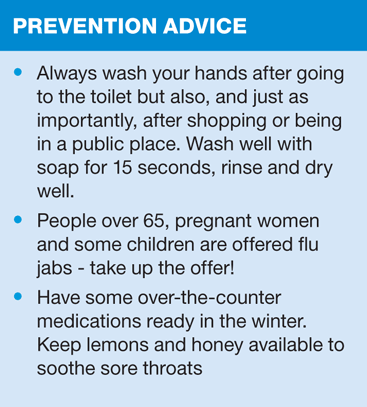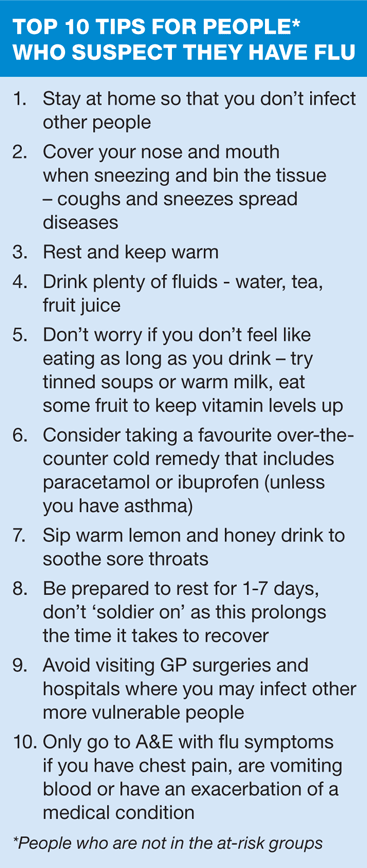Top tips for patients to help combat flu
Sara Richards
Sara Richards
RGN, Specialist Primary Care Nurse
Self Care Forum board member
Local nurse on Slough CCG Governing Body
In the winter months nurses are extremely busy seeing people with minor ailments as well as giving the flu vaccinations on top of their usual workload, so a short time spent encouraging patients to self care for colds and flu will, in the end, lighten the load.
Flu (influenza) is an acute viral infection, characterised by all or some of the following: fever, chills, headache, sore throat, muscle and or joint aches and pains and tiredness. The symptoms develop fairly quickly and can be really unpleasant. It is a self-limiting disease in healthy individuals and recovery is usual in two to seven days. It is a good idea to educate people to recognise these 'normal' symptoms and to suggest the top ten tips for self care so that they can look after themselves at home.
However, in young children, the very elderly, at risk groups or immunocompromised individuals, flu can progress from a mild flu-like illness with symptoms as described above to one in which there is shortness of breath, chest pain or confusion, which may be indicative of pneumonia, and/or a significant exacerbation of an underlying medical condition (such as heart, liver, lung or renal insufficiency, asthma or diabetes mellitus). These are symptoms that people need to understand so that they are aware of when to visit a GP or nurse or go to A&E.
Despite people's willingness to initially self-treat, there are still 57 million GP consultations a year for minor ailments at a total cost to the NHS of £2 billion, which takes up, on average, an hour a day for every GP. Research shows that people often abandon self care earlier than they need to, typically seeking the advice of a doctor within a period of 4-7 days.1 The main reasons for this are:
- Lack of confidence in understanding the normal progress of symptoms (e.g. a cold can last up to 14 days)
- The perceived severity and duration of symptoms
- Reassurance that nothing more serious is wrong
- Desire for a prescription to 'cure' the illness, even though the same medicine may be available over-the-counter (OTC)2
On presenting at the GP practice with flu-like symptoms patients often ask for antibiotics. This is still very common despite the fact that there has been campaign after campaign to encourage less demand. An 'Antibiotics do not kill viruses' campaign runs almost every winter but people still do not understand why they cannot have antibiotics.3 GPs and nurses should resist giving them on demand although it takes time to explain to the patient why they should not take them. According to the Chief Medical Officer, Professor Dame Sally Davies,4 inappropriate use of antimicrobials — that is, the use of drugs that are not effective against the microbes causing a disease, or patients not completing a course or treatment or missing doses — can promote the development of resistant microbes. Resistant pathogens are killing 25,000 people a year across Europe and resistance is becoming a global problem.5
A simple explanation given to the patients about the difference between viruses and bacteria may help them to understand why an antibiotic won't work for viruses.
WHAT ARE VIRUSES?
Viruses are too small to be seen by the naked eye. They can't multiply or survive on their own, so they have to invade a 'host' cell and take over its machinery in order to be able to make more virus particles. They only have one goal: to multiply. The cells of the mucous membranes, such as those lining the respiratory passages that we breathe through, are particularly open to virus attacks because they are not covered by protective skin. There is no medicine that gets rid of a virus at the moment without also damaging the 'host' cell.
WHAT ARE BACTERIA?
Bacteria are organisms made up of just one cell. They are capable of multiplying by themselves, as they have the power to divide. Bacteria exist everywhere, inside and on our bodies. Most of them are completely harmless and some of them are very useful. But some bacteria can cause diseases, either because they end up in the wrong place in the body or simply because they are 'designed' to invade us. To kill off these harmful bacteria one must take antibiotics, however, the antibiotic kills off the good bacteria as well.
In the same way as you wouldn't use a water-filled fire extinguisher on a fat fire or electrical blaze — you would use a fire blanket or powder extinguisher, respectively — it is important to use the right drug to control the 'germ' that is causing the illness.
OTC MEDICATION
Nurses cannot recommend named over-the-counter medicines but can give descriptions of the most helpful ones for flu and colds with the warnings about not taking more than one with paracetamol or ibuprofen in it. The NHS Choices website6 has a useful list of OTC medicines, which describes each one, the side effects and how they treat the symptoms. This website can be recommended to patients.
CONCLUSION
Nurses see people for all sorts of reasons, some who are well and some who are ill. If a little time is taken at every opportunity to teach about self care then patients will have more confidence when they become ill in treating themselves before seeing the nurse or GP.
REFERENCES
1. McAteer A, Elliott AM. Hannaford PC. Ascertaining the size of the symptom iceberg in a UK-wide community-based survey. BJ Gen Pract 2011;61(582):e1-e11
2. Pillay N, Tisman A, Kent T, et al. The economic burden of minor ailments on the National Health Service (NHS) in the UK. Self Care 2010;1(3):105-116.
3. Self Care Forum. What do we mean by self care. Available at: http://www.selfcareforum.org/about-us/what-do-we-mean-by-self-care-and-why-is-good-for-people/
4. NHS Choices. The antibiotic awareness campaign. Available at: http://www.nhs.uk/NHSEngland/ARC/Pages/AboutARC.aspx
5. Davies S, Grant J and Catchpole M The Drugs don't work. Penguin2013
6. NHS Choices. Medicines for seasonal flu. Available at: http://www.nhs.uk/Conditions/Flu/Pages/MedicineGuidePage.aspx
Related articles
View all Articles

